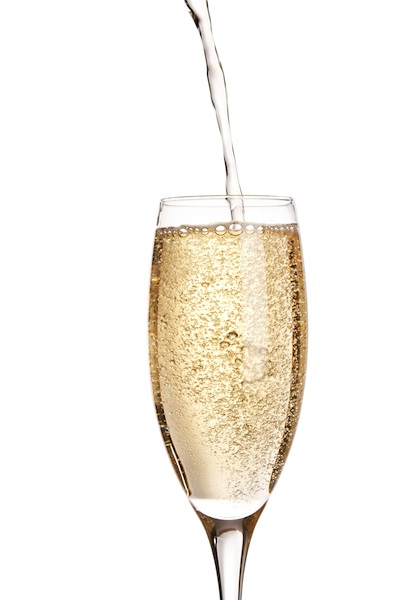With Thanksgiving behind us, the holiday season has arrived, and with it all the parties and merriment that entails. So I’ve decided to make December champagne month on Cluster Crush.
Not only is champagne the quintessential celebration libation, but about 50% of the champagne sold over the entire year in the US is sold in the final quarter…which makes sense thanks to all those holiday parties and the big bottle-popping festivities of New Year’s Eve.
Last year alone, champagne producers shipped 1.3 million cases, or 15.6 million bottles, of the stuff to the US. So hopefully you got a few glasses of it. Moët & Chandon and Veuve Clicquot alone accounted for around 60% of the total champagne sold here in the US.

About half the champagne sold in the US this year is in December – so have a glass or two!
Champagnes are usually a blend of three grape varieties: Chardonnay, Pinot Noir and Pinot Meunier. It might surprise you to learn that two of those varieties are actually red grapes! But the wine we end up with is usually white (or rosé) because the grapes are pressed so gently that the juice does not take on any color from the skin. There are actually a few more varieties that champagne-makers are permitted to blend into the wine, but it’s rare to find them, so don’t worry about them just now.
The way the typical champagne blend is usually described, Pinot Noir gives the wine its structure and body, the Chardonnay its acidity and backbone, and Pinot Meunier gives the blend a rounded, energetic, fruity quality. I don’t find that helps me conceive of the part each variety plays in the final product, though.
Instead, I prefer to think of it like this. If champagne were a bicycle, Pinot Noir would be like the metal frame – the main body and shape of the wine. The Chardonnay would be like the wheels. It provides a strong foundation for the wine, and gives it a linear energy and the ability to age that can take it far down the road. The Pinot Meunier is sort of like the bell on the handlebars. It’s loud and noticeable at first, and is a nice, shiny, lovely component, but not the main attraction.
If a champagne is designated blanc de blancs, or “white from whites,” it is made just from Chardonnay. If it is designated blanc de noirs, or “white from darks,” it is made from either or both Pinot Noir or Pinot Meunier.

Though champagne is typically white, there are two red grape varieties in it.
Pronounce it Bëtter
For other fun facts about champagne, check out this post on how champagne gets its sparkle. In the meantime, here’s a tip that will make you look like the most sophisticated person at your next holiday party. When you see the “ë” with an umlaut over it in the name of a champagne, such as Moët & Chandon, or Perrier-Jouët, you pronounce the “et” as you would in English. So Moët should sound like this: “moh-eht,” and Jouët should sound like: “zhoo-eht.” None of this “moh-ay” or “zhoo-ay” nonsense!
Stay tuned for future posts on champagne basics like sweetness and riddling, what to bring to your next holiday party, the perfect gift for wine-lovers in your life, and more!

